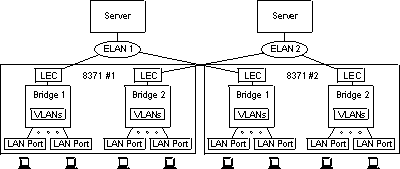

Support for multiple bridge instances allows the IBM 8371 to be partitioned into multiple, independent layer-2 switches. Up to 24 bridge instances may be configured. Each bridge instance maintains its own layer-2 database and has an independent instance of the spanning tree protocol.
Figure 1 depicts an example network design that uses the multiple bridge instance capability. In this example, each IBM 8371 is partitioned into two bridge domains. Each bridge domain is made up of a set of Ethernet ports and an Ethernet LEC. The LECs are members of ELANs that connect the 8371 switches.
Since each bridge has an independent instance of the spanning tree protocol, the parallel ELANs do not create a layer-2 loop. Therefore, all of the LECs can be forwarding traffic simultaneously, which is advantageous to ATM throughput.
The ports assigned to Bridge 1 effectively form a port-based VLAN and the 8371's other VLAN functions may be used to further refine the scope of broadcast/multicast traffic within the port-based domain.
While ports on different bridge instances are isolated at layer-2, stations of these ports may still communicate at layer 3. Release 1.0 of the IBM 8371 supports layer-3 switching using the MPOA client and Self-learning IP. Both of these layer-3 functions can switch traffic directly between ports that are members of different bridge instances. The 8371's local shortcut capability in the MPOA client enables layer-3 traffic to be switched directly between two Ethernet ports without traversing the ATM backbone.
Figure 1. Example Network Design with Multiple Bridge Instances
 |
The multiple bridge instance support also assists MPOA load balancing. Figure 2 illustrates one way that multiple bridge instances can be used in conjunction with MPOA. In this example, traffic for ports assigned to Bridge 1 is shortcutted over ATM interface 1, while traffic to and from ports assigned to Bridge 2 is shortcutted over ATM interface 2. The stations assigned to Bridge 1 may be on the same subnet as the stations assigned to Bridge 2, or on different subnets.
 |